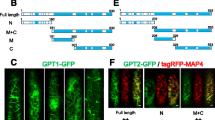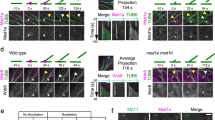Abstract
Nine genes that encode proteins of the MAP65 family have been identified in the Arabidopsis thaliana genome. In this study, we reported that AtMAP65-2, a member of the AtMAP65 family, could strongly stabilize microtubules (MTs). Bacterially-expressed AtMAP65-2 fusion proteins induced the formation of large MT bundles in vitro. Although AtMAP65-2 showed little effect on MT assembly or nucleation, AtMAP65-2 greatly stabilized MTs that were subjected to low-temperature treatment in vitro. Analyses of truncated versions of AtMAP65-2 indicated that the region that encompassed amino acids 495–578, which formed a flexible extended loop, played a crucial role in the stabilization of MTs. Analysis of suspension-cultured Arabidopsis cells that expressed the AtMAP65-2-GFP fusion protein showed that AtMAP65-2 co-localized with MTs throughout the cell cycle. Cortical MTs that were decorated with AtMAP65-2-GFP were more resistant to the MT-disrupting drug propyzamide and to ice treatment in vivo. The results of this study demonstrate that AtMAP65-2 strongly stabilizes MTs and is involved in the regulation of MT organization and dynamics.








Similar content being viewed by others
Abbreviations
- EGTA:
-
Ethylene glycol-bis-(β-aminoethyl ether)-N,N,N′,N′-tetraacetic acid
- MAPs:
-
Microtubule-associated proteins
- MT:
-
Microtubule
- PIPES:
-
Piperazine-N,N′-bis (2-ethanesulfonic acid; 1,4-piperazinediethanesulfonic acid)
References
Abdrakhamanova A, Wang QY, Khokhlova L, Nick P (2003) Is microtubule disassembly a trigger for cold acclimation? Plant Cell Physiol 44:676–686. doi:10.1093/pcp/pcg097
Al-Bassam J, Ozer RS, Safer D, Halpain S, Milligan RA (2002) MAP2 and tau bind longitudinally along the outer ridges of microtubule protofilaments. J Cell Biol 157:1187–1196. doi:10.1083/jcb.200201048
Bouquin T, Mattsson O, Naested H, Foster R, Mundy J (2003) The Arabidopsis lue1 mutant defines a katanin p60 ortholog involved in hormonal control of microtubule orientation during cell growth. J Cell Sci 116:791–801. doi:10.1242/jcs.00274
Burk DH, Liu B, Zhong R, Morrison WH, Ye ZH (2001) A katanin-like protein regulates normal cell wall biosynthesis and cell elongation. Plant Cell 13:807–827
Castoldia M, Popov A (2003) Purification of brain tubulin through two cycles of polymerization-depolymerization in a high-molarity buffer. Protein Exp Purif 32:83–88. doi:10.1016/S1046-5928(03)00218-3
Chan J, Rutten T, Lloyd C (1996) Isolation of microtubule-associated proteins from carrot cytoskeletons: a 120 kDa map decorates all four microtubule arrays and the nucleus. Plant J 10:251–259. doi:10.1046/j.1365-313X.1996.10020251.x
Chan J, Jensen CG, Jensen LCW, Bush M, Lloyd CW (1999) The 65-kDa carrot microtubule-associated protein forms regularly arranged filamentous cross-bridges between microtubules. Proc Natl Acad Sci USA 96:14931–14936. doi:10.1073/pnas.96.26.14931
Cyr RJ, Palevitz BA (1995) Organization of cortical microtubules in plant cells. Curr Opin Cell Biol 7:65–71. doi:10.1016/0955-0674(95)80046-8
Dehmelt L, Halpain S (2005) The MAP2/Tau family of microtubule-associated proteins. Genome Biol 6:195–204
Dixit R, Cyr R (2004) The cortical microtubule array: from dynamics to organization. Plant Cell 16:2546–2552. doi:10.1105/tpc.104.161030
Ehrhardt DW, Shaw SL (2006) Microtubule dynamics and organization in the plant cortical array. Annu Rev Plant Biol 57:859–875. doi:10.1146/annurev.arplant.57.032905.105329
Forreiter C, Kirschner M, Nover L (1997) Stable transformation of an Arabidopsis cell suspension culture with firefly luciferase providing a cellular system for analysis of chaperone activity in vivo. Plant Cell 9:2171–2181
Geelen DNV, Inze DG (2001) A bright future for the Bright Yellow-2 cell culture. Plant Physiol 127:1375–1379. doi:10.1104/pp.127.4.1375
Hamada T (2007) Microtubule-associated proteins in higher plants. J Plant Res 120:79–98. doi:10.1007/s10265-006-0057-9
Heald R, Nogales E (2002) Microtubule dynamics. J Cell Sci 115:3–4
Hussey PJ, Hawkins TJ, Igarashi H, Kaloriti D, Smertenko A (2002) The plant cytoskeleton: recent advances in the study of the plant microtubule-associated proteins MAP-65, MAP-190 and the Xenopus MAP215-like protein, MOR1. Plant Mol Biol 50:915–924. doi:10.1023/A:1021236307508
Hyman A (1991) Preparation of marked microtubules for the assay of the polarity of microtubule-based motors by fluorescence. J Cell Sci 14(Suppl):125–127
Jiang CJ, Sonobe S (1993) Identification and preliminary characterization of a 65 kDa higher-plant microtubule-associated protein. J Cell Sci 105:891–901
Kaloriti D, Galva C, Parupalli C, Khalifa N, Galvin M, Sedbrook JC (2007) Microtubule associated proteins in plants and the processes they manage. J Integr Plant Biol 49:1164–1173. doi:10.1111/j.1672-9072.2007.00541.x
Korolev AV, Chan J, Naldrett MJ, Doonan JH, Lloyd CW (2005) Identification of a novel family of 70 kDa microtubule-associated proteins in Arabidopsis cells. Plant J 42:547–555. doi:10.1111/j.1365-313X.2005.02393.x
Li H, Mao TL, Zhang ZD, Yuan M (2007) The AtMAP65-1 cross-bridge between microtubules is formed by one dimer. Plant Cell Physiol 48:866–874. doi:10.1093/pcp/pcm059
Liu J, Rost B (2003) NORSp: predictions of long regions without regular secondary structure. Nucleic Acids Res 31:3833–3835. doi:10.1093/nar/gkg515
Lloyd C, Hussey P (2001) Microtubule-associated proteins in plants—why we need a MAP. Nat Rev Mol Cell Biol 2:40–47. doi:10.1038/35048005
Mao TL, Jin LF, Li H, Liu B, Yuan M (2005) Two microtubule-associated proteins of the Arabidopsis MAP65 family function differently on microtubules. Plant Physiol 138:654–662. doi:10.1104/pp.104.052456
Muller S, Fuchs E, Ovecka M, Wysocka-Diller J, Benfey PN, Hauser MT (2002) Two new loci, PLEIADE and HYADE, implicate organ-specific regulation of cytokinesis in Arabidopsis. Plant Physiol 130:312–324. doi:10.1104/pp.004416
Muller S, Smertenko A, Wagner V, Heinrich M, Hussey PJ, Hauser MT (2004) The plant microtubule-associated protein AtMAP65-3/PLE is essential for cytokinetic phragmoplast function. Curr Biol 14:412–417. doi:10.1016/j.cub.2004.02.032
Rutten T, Chan J, Lloyd CW (1997) A 60-kDa plant microtubule-associated protein promotes the growth and stabilization of neurotubules in vitro. Proc Natl Acad Sci USA 94:4469–4474. doi:10.1073/pnas.94.9.4469
Shoji T, Suzuki K, Abe T, Kaneko Y, Shi H, Zhu JK, Rus A, Hasegawa PM, Hashimoto T (2006) Salt stress affects cortical microtubule organization and helical growth in Arabidopsis. Plant Cell Physiol 47:1158–1168. doi:10.1093/pcp/pcj090
Smertenko A, Saleh N, Igarashi H, Mori H, Hauser-Hahn I, Jiang C, Sonobe S, Lloyd C, Hussey P (2000) A new class of microtubule-associated proteins in plants. Nat Cell Biol 2:750–753. doi:10.1038/35036390
Smertenko A, Chang H, Wagner V, Kaloriti D, Fenyk S, Sonobe S, Lloyd C, Hauser M, Hussey P (2004) The Arabidopsis microtubule-associated protein AtMAP65-1: molecular analysis of its microtubule bundling activity. Plant Cell 16:2035–2047. doi:10.1105/tpc.104.023937
Smertenko A, Chang H, Sonobe S, Fenyk S, Weingartner M, Bögre L, Hussey P (2006) Control of the AtMAP65-1 interaction with microtubules through the cell cycle. J Cell Sci 119:3227–3237. doi:10.1242/jcs.03051
Teng J, Takei Y, Harada A, Nakata T, Chen J, Hirokawa N (2001) Synergistic effects of MAP2 and MAP1B knockout in neuronal migration, dendritic outgrowth, and microtubule organization. J Cell Biol 155:65–76. doi:10.1083/jcb.200106025
Van Damme D, Van Poucke K, Boutant E, Ritzenthaler C, Inzè D, Geelen D (2004a) In vivo dynamics and differential microtubule-binding activities of MAP65 proteins. Plant Physiol 136:3956–3967. doi:10.1104/pp.104.051623
Van Damme D, Bouget F, Van Poucke K, Inzè D, Geelen D (2004b) Molecular dissection of plant cytokinesis and phragmoplast structure: a survey of GFP-tagged proteins. Plant J 40:368–398. doi:10.1111/j.1365-313X.2004.02222.x
Wang C, Li J, Yuan M (2007a) Salt tolerance requires cortical microtubule reorganization in Arabidopsis. Plant Cell Physiol 48:1534–1547. doi:10.1093/pcp/pcm123
Wang X, Zhu L, Liu BQ, Wang C, Jin LF, Zhao Q, Yuan M (2007b) Arabidopsis MICROTUBULE-ASSOCIATED PROTEIN18 functions in directional cell growth by destabilizing cortical microtubules. Plant Cell 19:877–889. doi:10.1105/tpc.106.048579
Wasteneys G, Galway M (2003) Remodeling the cytoskeleton for growth and form: an overview with some new views. Annu Rev Plant Biol 54:691–722. doi:10.1146/annurev.arplant.54.031902.134818
Whittington AT, Vugrek O, Wei KJ, Hasenbein NG, Sugimoto K, Rashbrooke MC, Wasteneys GO (2001) MOR1 is essential for organizing cortical microtubules in plants. Nature 411:610–613. doi:10.1038/35079128
Wicker-Planquart C, Stoppin-Mellet V, Blanchoin L, Vantard M (2004) Interactions of tobacco microtubule-associated protein MAP65-1b with microtubules. Plant J 39:126–134. doi:10.1111/j.1365-313X.2004.02115.x
Yuan M, Shaw P, Warn R, Lloyd C (1994) Dynamic reorientation of cortical microtubules, from transverse to longitudinal, in living plant cells. Proc Natl Acad Sci USA 91:6050–6053. doi:10.1073/pnas.91.13.6050
Acknowledgements
We thank Dr. Bo Liu at UC Davis for critical reading of and comments on the manuscript. This research was supported by the National Key Basic Research Project of China (Grant 2006CB100101 to M. Y.) and National Natural Science Foundation of China (Grants 30421002, 30370707, and 30570925 to M. Y.; 30600312, and 30770186 to T. M.).
Author information
Authors and Affiliations
Corresponding author
Additional information
H. Li and X. Zeng have contributed equally to this paper and are considered as joint first authors.
Electronic supplementary material
Below is the link to the electronic supplementary material.
Supplementary Fig. 1
Sequence alignment between the truncated versions of AtMAP65-1 and AtMAP65-2. a Sequence identity between AtMAP65-2 1-339 and AtMAP65-1 1–339 was ~83.78%. b Sequence identity between AtMAP65-2 340–578 and AtMAP65-1 340–587 was ~59.14%. (TIFF 13065 kb)
Supplementary Fig. 2
The truncated AtMAP65-2 proteins co-sediment with MTs. The His-AtMAP65-2 340–578, 1–339, 340–494, 495–578, and GST-AtMAP65-2 1–494 fusion proteins were incubated in the presence or absence of 4 μM MTs. After centrifugation, the supernatants and pellets were subject to SDS-PAGE analysis. Lanes 1 and 2, at a concentration of 0.5 μM, the truncated proteins bound to MTs. Lanes 3 and 4, at a concentration of 5 μM, the truncated proteins bound to MTs. Lanes 5 and 6, 5 μM fusion proteins in the absence of MTs. (TIFF 3339 kb)
Rights and permissions
About this article
Cite this article
Li, H., Zeng, X., Liu, ZQ. et al. Arabidopsis microtubule-associated protein AtMAP65-2 acts as a microtubule stabilizer. Plant Mol Biol 69, 313–324 (2009). https://doi.org/10.1007/s11103-008-9426-1
Received:
Accepted:
Published:
Issue Date:
DOI: https://doi.org/10.1007/s11103-008-9426-1




